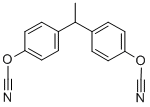cyanic acid
- CAS NO.:420-05-3
- Empirical Formula: CHNO
- Molecular Weight: 43.02
- MDL number: MFCD00871274
- SAFETY DATA SHEET (SDS)
- Update Date: 2024-12-18 14:15:32

What is cyanic acid?
Chemical properties
Colorless liquid or gas with an acrid smell; mp -86°C (-122.8°F); bp 23.5°C (74.3°F); density 1.140 at 20°C (68°F); soluble in water, alcohol, ether, benzene, and toluene.
The Uses of cyanic acid
In formation of some cyanates.
The Uses of cyanic acid
Hydrogen cyanate is used in the preparation of cyanates.
Definition
cyanic acid: An unstable explosiveacid, HOCN. The compound has thestructure H–O–C≡N, and is also calledfulminic acid. Its salts and esters arecyanates (or fulminates). The compoundis a volatile liquid, whichreadily polymerizes. In water it hydrolysesto ammonia and carbondioxide. It is isomeric with anotheracid, H–N=C=O, which is known asisocyanic acid. Its salts and esters areisocyanates.
Health Hazard
Hydrogen cyanate is a severe irritant to the eyes, skin, and mucous membranes. Exposure to this compound can cause severe lacrimation. Inhalation can produce irritation and injury to the respiratory tract. LD50 values are not reported.
Fire Hazard
Flammable; the liquid can explode when heated rapidly.
Waste Disposal
Hydrogen cyanate can be disposed of in the drain in small amounts. It decomposes in water forming CO2 and NH3.
Properties of cyanic acid
| Melting point: | -86° |
| Boiling point: | bp760 23.5° |
| Density | d420 1.140; d4-20 1.156 |
| refractive index | 1.4300 (estimate) |
| pka | 3.7(at 25℃) |
| Exposure limits | No exposure limit has yet been set for this compound. |
| EPA Substance Registry System | Cyanic acid (420-05-3) |
Safety information for cyanic acid
Computed Descriptors for cyanic acid
New Products
Methyl (R)-1-Boc-4,4-difluoropyrrolidine-2-carboxylate 2,2-Difluoropropylamine hydrochloride tert-butyl 3-bromoazetidine-1-carboxylate (R)-1-Boc-3-hydroxypyrrolidine DIFLUOROACETIC ANHYDRIDE 2,2-Difluoropropionic acid Diallylamine, 99% Calcium hydroxide, 95% Aluminum oxide, basic 2-Bromophenylacetonitrile, 97% L-tert-Leucine,97% N-Hydroxy-2-methylpropanimidamide 4-(3,4-Dichlorophenyl)-3,4-Dihydro-N-Methyl-1-(2H)-Naphthalenimine (Schiff Base) 2-AMINO-3,5-DIBROMO BENZALDEHYDE [ADBA] L-Glutamic Acid Dimethyl Ester Hcl 10-Methoxy-5H-dibenz[b,f]azepine 5-Cyanophthalide N, N-Carbonyldiimidazole (CDI) Dibenzoyl Peroxide Titanium Dioxide 2-(Methylthio) Benzonitrile Sodium Acetate Anhydrous Allopurinol 1,5-DibromopentaneRelated products of tetrahydrofuran








You may like
-
![Cis-2-(Bromomethyl)-2-(2,4-Dichlorophenyl)-1,3-Dioxolane-4-Ylmethyl Benzoate [CBB] 61397-56-6 99%](https://img.chemicalbook.in//Content/image/CP5.jpg) Cis-2-(Bromomethyl)-2-(2,4-Dichlorophenyl)-1,3-Dioxolane-4-Ylmethyl Benzoate [CBB] 61397-56-6 99%View Details
Cis-2-(Bromomethyl)-2-(2,4-Dichlorophenyl)-1,3-Dioxolane-4-Ylmethyl Benzoate [CBB] 61397-56-6 99%View Details
61397-56-6 -
 287930-77-2 / 142569-70-8 99%View Details
287930-77-2 / 142569-70-8 99%View Details
287930-77-2 / 142569-70-8 -
![2033-24-1 2,2-Dimethyl-1,3-Dioxane-4,6-Dione [Meldrum Acid] 98%](https://img.chemicalbook.in//Content/image/CP5.jpg) 2033-24-1 2,2-Dimethyl-1,3-Dioxane-4,6-Dione [Meldrum Acid] 98%View Details
2033-24-1 2,2-Dimethyl-1,3-Dioxane-4,6-Dione [Meldrum Acid] 98%View Details
2033-24-1 -
 Ethyl-2-Chloroacetoacetate 609-15-4View Details
Ethyl-2-Chloroacetoacetate 609-15-4View Details
609-15-4 -
 CIS- BROMO BENZOATEView Details
CIS- BROMO BENZOATEView Details
61397-56-6 -
 609-15-4View Details
609-15-4View Details
609-15-4 -
![1-(6-Methylpyridin-3-Yl)-2-[4-(Methylsulfonyl)Phenyl]Ethanone [Ketosulfone] 99%](https://img.chemicalbook.in//Content/image/CP5.jpg) 1-(6-Methylpyridin-3-Yl)-2-[4-(Methylsulfonyl)Phenyl]Ethanone [Ketosulfone] 99%View Details
1-(6-Methylpyridin-3-Yl)-2-[4-(Methylsulfonyl)Phenyl]Ethanone [Ketosulfone] 99%View Details
221615-75-4 -
 27143-07-3View Details
27143-07-3View Details
27143-07-3
